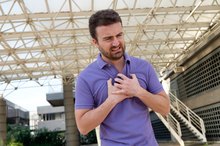How to Know If Left Arm Pain Is Heart Related
Pain in the left arm can be due to many causes, ranging from a pulled muscle to a massive heart attack 2. While it is not always possible to determine whether left arm pain is due to an insignificant cause or something potentially serious, several features can help distinguish the difference.
If you are experiencing serious medical symptoms, seek emergency treatment immediately.
Chest Pain With Left Arm Pain
While not always cause for alarm, the combination of pain or heaviness in the chest accompanied by pain in the left arm requires immediate medical attention under most circumstances, as it may be difficult to determine whether this is symptomatic of a serious condition. Some instances are highly unlikely to be serious, such as when a 21-year-old develops chest and arm pain after falling forward during a strenuous game of racquetball.
Other Symptoms With Arm Pain
My Heart Goes Out of Rhythm When I Squat
Learn More
Heart-related symptoms are sometimes not clear-cut, and some people who have severe heart disease never experience chest discomfort. It is even possible to have a heart attack with few, if any, symptoms. The human body does not always follow the classic, textbook description of a heart attack with excruciating chest pain that feels like an elephant sitting on the chest. Sometimes more vague symptoms occur, such as shortness of breath, nausea, indigestion, dizziness, unusual sweating or a racing heartbeat. If left arm pain accompanies any of these symptoms, it suggests the possibility of a heart problem.
- Heart-related symptoms are sometimes not clear-cut, and some people who have severe heart disease never experience chest discomfort.
Reproducible Arm Pain
Pain in the left arm that is brought on by movement or pushing on the painful area is typically less likely to be heart related. Simple activities, such as lifting weights or moving heavy furniture, can cause a strain or inflammation in the arm muscles or joints. The pain associated with these types of injuries can often be reproduced by simple maneuvers, such as simply pushing on the area in question. Arm pain also can be caused by a pinched nerve in the neck, and moving the neck around may bring on the pain. Pain related to the heart is typically not brought on by moving the arm.
- Pain in the left arm that is brought on by movement or pushing on the painful area is typically less likely to be heart related.
- Arm pain also can be caused by a pinched nerve in the neck, and moving the neck around may bring on the pain.
Persistent Pain
Why Does the Right Side of Your Chest Hurt?
Learn More
If left arm pain persists for a long time, it is less likely to be related to a heart problem. Conditions such as rotator cuff tendinitis and arthritis may persist for months or even years, making the likelihood of an association with heart disease highly unlikely. At the other end of the spectrum, lightning-fast, sharp pains in the arm are also less likely to be related to heart disease, especially if brought on by moving the arm or neck.
- If left arm pain persists for a long time, it is less likely to be related to a heart problem.
- At the other end of the spectrum, lightning-fast, sharp pains in the arm are also less likely to be related to heart disease, especially if brought on by moving the arm or neck.
Warnings
Left arm pain that gets worse with activity and improves with rest should prompt immediate medical attention, as this may be a sign of heart disease -- especially if the pain is deep and the arm is not tender to the touch. Left arm pain that appears suddenly while at rest, such as when watching television, could also be due to an unstable heart condition. Finally, if the arm pain is accompanied by any combination of chest pain, nausea, vomiting, dizziness, passing out, shortness of breath, unusual sweating, abdominal bloating, cough or wheezing, seek medical attention immediately.
- Left arm pain that gets worse with activity and improves with rest should prompt immediate medical attention, as this may be a sign of heart disease -- especially if the pain is deep and the arm is not tender to the touch.
Related Articles
References
- Journal of the American College of Cardiology: 2011 ACCF/AHA Focused Update Incorporated Into the ACC/AHA 2007 Guidelines for the Management of Patients With Unstable Angina/Non–ST-Elevation Myocardial Infarction
- Current Medical Diagnosis and Treatment 2014; Maxine A. Papadakis, M.D., et al.
- UptoDate: Clinical Features and Diagnosis of Cervical Radiculopathy
- Fu R, Li SD, Song CX, et al. Clinical significance of diabetes on symptom and patient delay among patients with acute myocardial infarction-an analysis from China Acute Myocardial Infarction (CAMI) registry. J Geriatr Cardiol. 2019;16(5):395-400. doi:10.11909/j.issn.1671-5411.2019.05.002
- Bilora F, Ceresa M, Milan M, Sarolo L, Prandoni P. The impact of deep vein thrombosis on the risk of subsequent cardiovascular events: a 14-year follow-up study. Int Angiol. 2017;36(2):156-159. doi:10.23736/S0392-9590.16.03664-6
- Bellet RN, Lamb RL, Gould TD, Bartlett HJ. Prevalence of neuro-musculoskeletal pain and dysfunction in open-heart surgical patients preoperatively and at 6 and 12 weeks postoperatively: a prospective longitudinal observation study. Pragmat Obs Res. 2017;8:211-222. doi:10.2147/POR.S131060
- National Institutes of Health, U.S. National Library of Medicine: MedlinePlus. Chest Pain. Updated August 4, 2020.
Writer Bio
Dr. Ann M. Hester is a board-certified internal medicine specialist and author. She is also the creator of the Patient Whiz patient engagement app for iOS and Total en Salud health app in Spanish.






